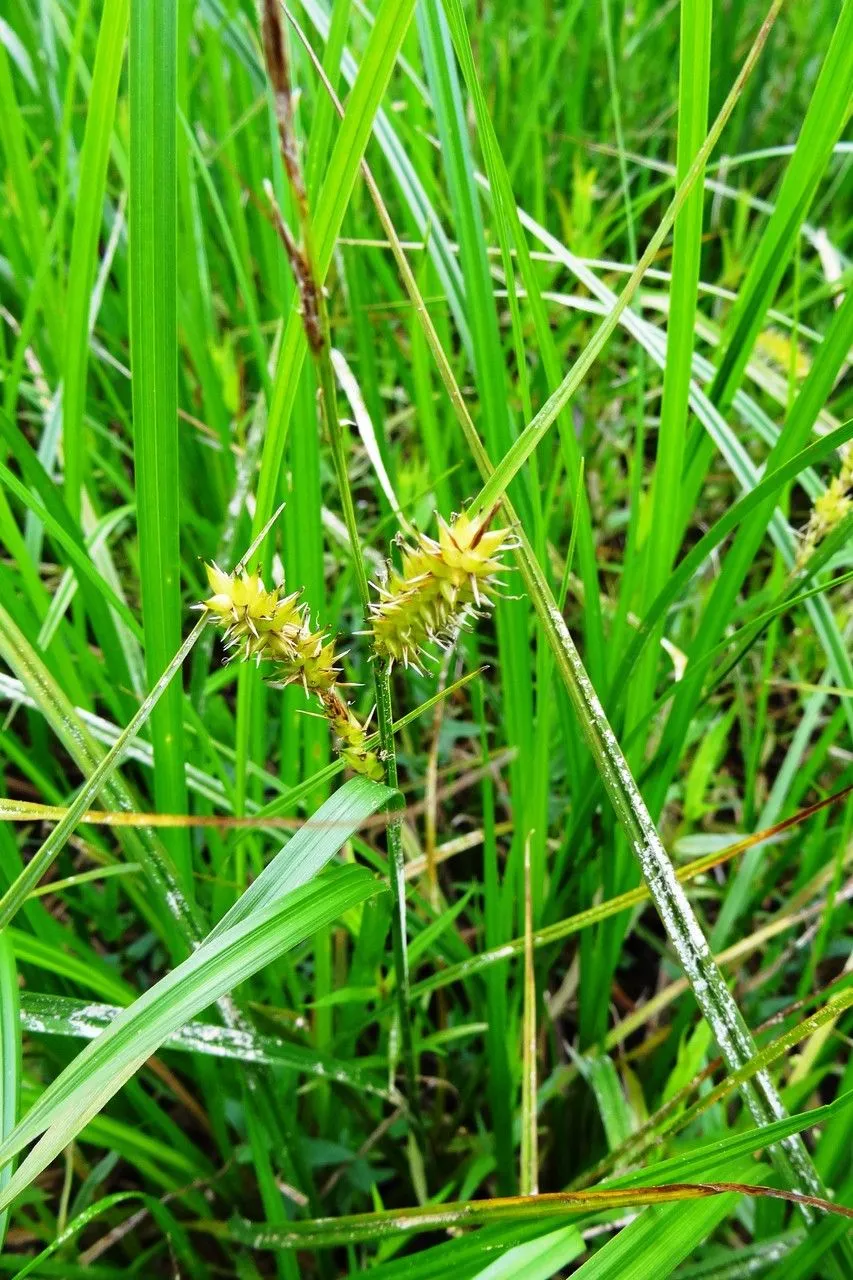
Author: L.
Bibliography: Sp. Pl.: 979 (1753)
Year: 1753
Status: accepted
Rank: species
Genus: Carex
Vegetable: False
Observations: Canada to U.S.A., Europe to C. Asia
Bladder sedge, known scientifically as Carex vesicaria, is a widespread species that belongs to the Cyperaceae family. This robust sedge inhabits a range extending from Canada to the United States and across Europe to Central Asia. The plant thrives in wetland environments, often found in marshes, fens, and along streams and lakeshores.
Renowned for its distinctive inflated spikelets, Bladder sedge stands out in its natural habitats. These spikelets, which appear like bladders or sacs, give the plant its common name. The foliage comprises long, grass-like leaves that arch gracefully, contributing to the plant’s aesthetic and ecological value in wetland ecosystems.
The botanical classification of Bladder sedge traces back to Carl Linnaeus, who included it in his seminal work Species Plantarum in 1753. Linnaeus’s formal description laid the foundation for the plant’s identification and classification within the diverse genus Carex, a group notable for its ecological significance in wetland areas.
Bladder sedge plays a crucial role in its habitats by stabilizing soil, preventing erosion, and providing a habitat for various wildlife species. Its ability to thrive in waterlogged conditions makes it a valuable indicator of healthy wetland ecosystems. Conservation efforts often emphasize the importance of preserving such native sedges to maintain the biodiversity and functionality of these vital ecological areas.
In summary, Carex vesicaria or Bladder sedge, is a plant of considerable interest due to its wide geographic distribution, unique morphological features, and essential ecological functions. Its presence across continents underscores the adaptability and significance of this Cyperaceae family member in wetland conservation and biodiversity.
Eng: bladder sedge, blister sedge, bladder-sedge, inflated sedge, lesser bladder sedge, small inflated sedge, tufted lake sedge
Deu: blasen-segge
Dan: blære-star
Nld: blaaszegge
Swe: blåsstarr, luhtasara
Fra: carex vésiculeux, laîche vésiculeuse
Fin: luhtasara
Nob: sennegras
Nno: sennegras
Sme: rievdnelukti, rievdneguodja
Cym: hesgen chwysigennaidd, hesgen chwysigennaidd berdywysennog
En: Bladder sedge, Blister sedge, Bladder-sedge, Inflated sedge, Lesser bladder sedge, Small inflated sedge, Tufted lake sedge
Da: Blære-star
Nl: Blaaszegge
Fi: Luhtasara
Fr: Carex vésiculeux, Laîche vésiculeuse, Laiche à utricules renflés, Laîche à utricules renflés, Laiche vésiculeuse
De: Blasen-Segge
It: Carice vescicosa
Se: Rievdnelukti, Rievdneguodja
Nb: Sennegras
Nn: Sennegras
Sv: Blåsstarr, Luhtasara
Cy: Hesgen Chwysigennaidd, Hesgen Chwysigennaidd Berdywysennog
Taken May 11, 2018 by Tela Botanica − Michel PANSIOT (cc-by-sa)
Taken May 24, 2020 by valada Sebka (cc-by-sa)
Taken May 10, 2015 by Tela Botanica − Yoan MARTIN (cc-by-sa)
Taken Jun 10, 2020 by Alain Bigou (cc-by-sa)
Taken Jun 10, 2020 by Alain Bigou (cc-by-sa)
Taken May 10, 2015 by Tela Botanica − Yoan MARTIN (cc-by-sa)
Taken May 10, 2015 by Tela Botanica − Yoan MARTIN (cc-by-sa)
Taken May 13, 2009 by Tela Botanica − Mathieu MENAND (cc-by-sa)
Taken May 10, 2015 by Tela Botanica − Yoan MARTIN (cc-by-sa)
Taken Jun 10, 2020 by Alain Bigou (cc-by-sa)
Taken May 20, 2018 by Tela Botanica − Christine JOURDAN (cc-by-sa)
Taken May 20, 2018 by Tela Botanica − Christine JOURDAN (cc-by-sa)
Taken Jun 17, 2011 by Tela Botanica − David MERCIER (cc-by-sa)
Taken Jan 7, 2020 by Michel (cc-by-sa)
Taken Dec 22, 2019 by jeanne Bosson (cc-by-sa)
© copyright of the Board of Trustees of the Royal Botanic Gardens, Kew.
© copyright of the Board of Trustees of the Royal Botanic Gardens, Kew.
Taken Apr 19, 2017 by Yoan MARTIN (cc-by-sa)
Taken May 17, 2015 by Tela Botanica − Jean-Claude CALAIS (cc-by-sa)
Taken May 10, 2015 by Tela Botanica − Yoan MARTIN (cc-by-sa)
Taken May 10, 2015 by Tela Botanica − Yoan MARTIN (cc-by-sa)
Taken Jun 4, 2014 by Tela Botanica − LE ROY Jean-Pierre (cc-by-sa)
Taken Aug 15, 2002 by Photoflora – Benoit BOCK (©)
Taken Aug 15, 2002 by Photoflora – Benoit BOCK (©)
Taken Jan 1, 1970 by Photoflora – L’Abbé COSTE (©)
Taken May 15, 2010 by Photoflora – Benoit BOCK (©)
Taken Jun 30, 1853 by Tela Botanica − Herbier PONTARLIER-MARICHAL (cc-by-sa)
Taken Jan 1, 1900 by EOL − Encyclopedia of Life (cc-by-nc-sa)
Taken Jun 17, 2011 by Tela Botanica − David MERCIER (cc-by-sa)
Taken Jul 3, 2019 by Tela Botanica − Marie Portas (cc-by-sa)
Growth form: Rhizomatous
Growth habit: Graminoid
Growth rate: Moderate
Ph maximum: 7.5
Ph minimum: 4.5
Light: 7
Atmospheric humidity: 8
Soil nutriments: 5
Family: Myrtaceae Author: (F.Muell.) K.D.Hill & L.A.S.Johnson Bibliography: Telopea 6: 402 (1995) Year: 1995 Status:…
Family: Rubiaceae Author: Pierre ex A.Froehner Bibliography: Notizbl. Bot. Gart. Berlin-Dahlem 1: 237 (1897) Year:…
Family: Sapindaceae Author: Koidz. Bibliography: J. Coll. Sci. Imp. Univ. Tokyo 32(1): 38 (1911) Year:…
Family: Asteraceae Author: A.Gray Bibliography: Pacif. Railr. Rep.: 107 (1857) Year: 1857 Status: accepted Rank:…
Family: Fabaceae Author: Medik. Bibliography: Vorles. Churpfälz. Phys.-Ökon. Ges. 2: 398 (1787) Year: 1787 Status:…
Family: Aspleniaceae Author: (Cav.) Alston Bibliography: Bull. Misc. Inform. Kew 1932: 309 (1932) Year: 1932…